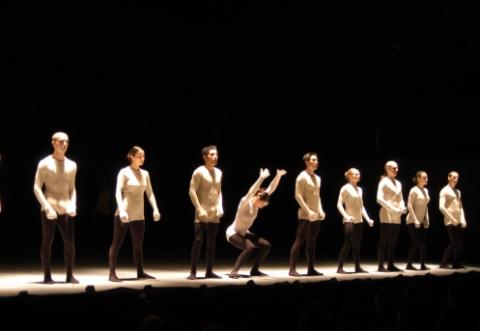Naharin's Virus
To conservatives in Israel, Mr. Naharin's avant-garde style, full of turbulent dynamics, is a destabilizing form of art. In a highly publicized and complex incident, the company withdrew from 50th-anniversary jubilee celebrations in Israel in 1998 when prominent ultra-Orthodox politicians objected to a performance by the dancers in their underwear.
In his public statements, Mr. Naharin has made no secret of his advocacy of Palestinian-Israeli reconciliation or of his disagreement with his government's current policies. Part of the music, heard on tape, in ''Naharin's Virus'' is by an Israeli Arab composer, Habib Allah Jamal (whose ensemble will perform at the academy's BAMcafé on Friday and Saturday at 9 p.m.).
The collaboration may be symbolic, but the work is less a protest piece than a conceptual formal piece with a tinge of protest.
The springboard is ''Offending the Audience,'' a 1966 play by the Austrian avant-garde playwright Peter Handke. As Jesper Thirup Hansen, a company member, stands on a platform above a stagewide blackboard, he recites in English part of the play's text. Most of it questions theater conventions and hardly seems startling today. Even the cascade of insults hurled toward the audience at the end has more wit than aggression.
The anger, if any, is in the movement. There is an especially strong image when the dancers bend their knees and beat their fists in the air as if banging down an invisible door.
Anyone who followed Mr. Naharin's early dances in New York in the 1980's, before he became a sought-after choreographer in companies abroad, will also recall his flowing, cursive way with movement. This calligraphy of the body is stunning in ''Naharin's Virus,'' and it distinguishes the choreography from some of the more emphatic movements seen with Batsheva since Mr. Naharin became the company's artistic director in 1990.
There is even an ingenious stylization of this oozing flow in the image that first greets viewers. A balloon stick figure, powered by air coming from a jar below, tilts, arches and swerves on its pedestal. When the strong beat of Mr. Jamal's music is added, the balloon seems suddenly to reveal its internal rhythm.
The human counterpart to this twisting figure is a woman who arches as she writes on the board behind her. Other men and women enter, all dressed in Rakefet Levy's flesh leotards over black tights: nudity without nudity.
The Arab songs alternate with silence in Karni Postel's collage score, which also includes Samuel Barber's music. The dancers divide into units and erupt into flailing solos, sometimes accompanied by childhood reminiscences on tape. (''When I told my mother God is an invention like pizza, she cried.'')
Along the way, the dancers draw and write on the blackboard, which is also a wall. The word Palestine is intentionally misspelled. What this has to do with Mr. Handke's text is an open question. But the power of the entire piece lies in its very fragmentation.
Anna Kisselgoff
www.nytimes.com
Naharin’s Virus – June 11th-13th, 25th-28th, Suzanne Dellal Centre, Tel Aviv.

